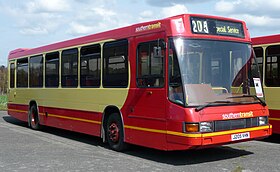| Revision as of 20:53, 20 February 2010 editPhilalg (talk | contribs)2 editsNo edit summary← Previous edit | Revision as of 20:08, 7 September 2010 edit undoAlzarian16 (talk | contribs)Pending changes reviewers9,798 edits Remove outdated info and complete rubbish. Will add sourcesNext edit → | ||
| Line 31: | Line 31: | ||
| The overall design stems from a design exercise into a new trolleybus for the proposed Leeds Trolleybus network in the 1980s. Although the trolleybus network didn’t come to fruition due to political and financial reasons the design was used for the Delta, with very few minor alterations. These included the removal of trolley poles (since the Delta would be powered by a diesel engine these weren’t required) and the replacement of a smooth panel emblazoned with ‘Optare’ with a conventional grill between the headlights. | The overall design stems from a design exercise into a new trolleybus for the proposed Leeds Trolleybus network in the 1980s. Although the trolleybus network didn’t come to fruition due to political and financial reasons the design was used for the Delta, with very few minor alterations. These included the removal of trolley poles (since the Delta would be powered by a diesel engine these weren’t required) and the replacement of a smooth panel emblazoned with ‘Optare’ with a conventional grill between the headlights. | ||
| The design of the Delta was continued in a less dramatic form onto the ]. | |||
| The Delta sold well during its lifetime but production of the Delta ceased in 1999. | The Delta sold well during its lifetime but production of the Delta ceased in 1999. | ||
| A large number of Optare Deltas are still in use with bus operating companies in the UK, most widely used by ]. They are found in high numbers with ], with the Darlington and Bishop depot having around 18 between them. | |||
| With companies like Arriva, the Optare Delta was a direct replacement for the aging ] fleet. | |||
| ==Optare Delta in culture== | ==Optare Delta in culture== | ||
Revision as of 20:08, 7 September 2010
| This article does not cite any sources. Please help improve this article by adding citations to reliable sources. Unsourced material may be challenged and removed. Find sources: "Optare Delta" – news · newspapers · books · scholar · JSTOR (February 2007) (Learn how and when to remove this message) |
| Optare Delta | |
|---|---|
 An Optare Delta owned by Southern Transit An Optare Delta owned by Southern Transit | |
| Body and chassis | |
| Doors | 1 or 2 door |
| Floor type | Step entrance |
| Chassis | DAF SB220 |
| Powertrain | |
| Engine | DAF 1160 |
| Transmission | ZF Automatic |
The Optare Delta is a single-decker bus body produced for the DAF SB220 chassis.
The dramatic front windscreen was a product of the designer’s experience of driving buses as it maximized driver visibility. It was also an attempt to disguise the bulge of the DAF SB220 chassis stylistically.
The overall design stems from a design exercise into a new trolleybus for the proposed Leeds Trolleybus network in the 1980s. Although the trolleybus network didn’t come to fruition due to political and financial reasons the design was used for the Delta, with very few minor alterations. These included the removal of trolley poles (since the Delta would be powered by a diesel engine these weren’t required) and the replacement of a smooth panel emblazoned with ‘Optare’ with a conventional grill between the headlights.
The Delta sold well during its lifetime but production of the Delta ceased in 1999.
Optare Delta in culture
An Optare Delta in all-over red livery (resembling Stagecoach London) is featured as a driveable vehicle in the PlayStation 2 game The Getaway, and its sequel The Getaway: Black Monday. They are commonly found driving around in most areas in these games, readily available to be "bus-jacked" at any time.
See also
| East Lancashire Coachbuilders / Darwen Group | |||||||||||||||
|---|---|---|---|---|---|---|---|---|---|---|---|---|---|---|---|
| |||||||||||||||
| |||||||||||||||
This bus-related article is a stub. You can help Misplaced Pages by expanding it. |